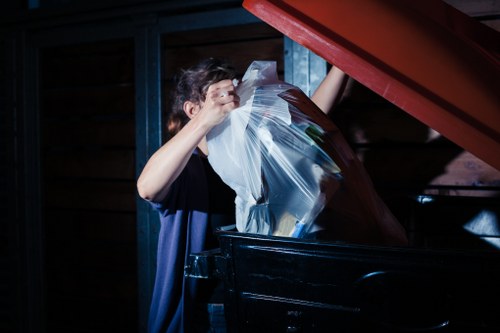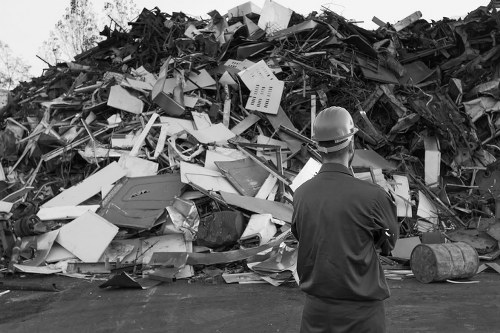Council Large Item Collection in Garden Clearance

Garden clearance is an essential task for homeowners aiming to maintain the beauty and functionality of their outdoor spaces. Whether you're preparing your garden for a season change, renovating, or simply decluttering, understanding the process of council large item collection can make the task more manageable and environmentally friendly.
Engaging in a comprehensive garden clearance not only enhances your property's curb appeal but also contributes to the community's overall cleanliness and sustainability. Many councils offer specific services tailored to help residents efficiently dispose of large items, ensuring minimal impact on the environment.
In this article, we'll delve deep into the intricacies of council large item collection in garden clearance. From understanding what items are eligible to scheduling a collection, we aim to provide a thorough guide to assist you in this endeavor.
Understanding Council Large Item Collection

Council large item collection is a service provided by local authorities to help residents dispose of bulky waste that cannot be handled through regular waste collection services. These items often include old furniture, appliances, garden equipment, and other sizeable household goods.
Each council may have specific guidelines and schedules for large item collections. It's crucial to familiarize yourself with your local council's policies to ensure a smooth and efficient clearance process.
Typically, councils offer a certain number of free large item collections per household each year. Additional collections may be available for a fee, depending on the council's regulations and the volume of waste being disposed of.
Scheduling a Collection

Scheduling a council large item collection is a straightforward process, but it requires planning to align with the council's availability. Most councils allow residents to book a pickup either online, via phone, or through a written request.
When scheduling a collection, ensure that you provide accurate details about the items you wish to dispose of. This information helps the council allocate the necessary resources and ensures that your large items are collected promptly.
It's advisable to schedule your collection well in advance, especially during peak seasons when demand for these services increases. Early booking can help avoid delays and ensure that your garden clearance proceeds on schedule.
Items Eligible for Collection

Understanding which items are eligible for council large item collection is vital to avoid any inconvenience during the clearance process. Generally, the following items are commonly accepted:
- Old furniture such as sofas, beds, and tables
- Electrical appliances like refrigerators, washing machines, and ovens
- Garden equipment, including lawnmowers, shredders, and bulky garden furniture
- Mattresses and box springs
- Large electronic items such as TVs and computers
However, certain items may not be eligible due to safety regulations or environmental concerns. It's essential to check with your local council to confirm the eligibility of specific items before scheduling a collection.
Additionally, hazardous waste items such as chemicals, pesticides, and batteries often require special handling and should not be included in standard large item collections. Councils typically provide separate disposal methods for these materials.
Preparing Items for Collection

Properly preparing your large items for council collection ensures a smooth and efficient clearance process. Start by segregating items that are eligible for collection from those that are not. Remove any personal belongings or hazardous materials from the items you intend to dispose of.
It's also recommended to disassemble large pieces of furniture if possible. Breaking down items can make transportation easier and reduce the risk of damage during collection.
Ensure that the items are accessible for the collection crew. Clear any obstacles that might hinder the transporters from reaching your large items. Placing the items near the designated collection point on the scheduled day helps facilitate a swift pickup.
Recycling and Disposal Practices

Councils prioritize environmentally responsible disposal and recycling practices. Before collecting your large items, they assess whether the items can be repaired, reused, or recycled to minimize landfill waste.
Many councils collaborate with local recycling centers and charities to repurpose items. For instance, old furniture might be donated to community centers or refurbished for secondary use.
Recycling reduces the environmental footprint of waste disposal and supports sustainability initiatives within the community. By participating in council large item collections, residents contribute to these positive environmental practices.
Tips for Efficient Garden Clearance

Efficient garden clearance requires strategic planning and organization. Here are some essential tips to streamline the process:
- Create a comprehensive list: Enumerate all the large items you intend to dispose of. This list will help you during scheduling and ensure that no items are overlooked.
- Sort items based on category: Group similar items together to simplify the collection process and aid in recycling efforts.
- Measure access points: Ensure that large items can be easily moved from your garden to the collection point without obstruction.
- Arrange for temporary storage: If there’s a delay in the collection date, have a designated area to safely store items without them cluttering your garden.
- Follow council guidelines: Adhere to your council’s specific requirements regarding large item collections to avoid any complications.
Avoiding Common Pitfalls

While garden clearance is beneficial, several common pitfalls can hinder the process. Being aware of these challenges allows you to navigate them effectively:
- Last-minute scheduling: Waiting until the last minute to schedule a collection can lead to delays and potential additional fees.
- Overloading the collection: Attempting to dispose of too many large items at once may exceed your council’s free collection quota.
- Neglecting proper preparation: Failing to prepare items adequately can result in damaged goods or a more complicated collection process.
- Ignoring non-eligible items: Attempting to include hazardous or non-eligible items in the large collection can cause disruptions and possible fines.
By planning ahead and following council guidelines, you can avoid these common issues and ensure a hassle-free garden clearance.
Environmental Benefits of Proper Collection

Proper council large item collection promotes environmental sustainability. By ensuring that bulky waste is disposed of correctly, councils help reduce the volume of waste that ends up in landfills, thereby conserving valuable land and resources.
Recycling large items decreases the demand for new raw materials, lowers energy consumption, and reduces greenhouse gas emissions associated with manufacturing processes.
Moreover, repurposing or donating items extends their lifecycle, fosters community spirit, and supports those in need. These practices collectively contribute to a healthier and more sustainable environment.
Frequently Asked Questions

Q1: How often can I schedule a council large item collection?
A1: The frequency of large item collections varies by council. Typically, residents are entitled to a certain number of free collections per year, with additional pickups available for a fee.
Q2: Are there any restrictions on the types of items I can dispose of?
A2: Yes, councils have specific guidelines on eligible items. Hazardous materials and certain electronics may require special disposal methods. Always check with your local council for detailed information.
Q3: What should I do if my large items are too big for the collection?
A3: If your items exceed the council's size or weight limits, you may need to arrange for alternative disposal methods, such as hiring a private removal service or taking the items to a recycling center.
Q4: Can I reschedule or cancel my large item collection?
A4: Most councils allow residents to reschedule or cancel a booked collection with adequate notice. Contact your council as soon as possible if changes are needed.
Q5: Is there a fee for additional large item collections?
A5: Additional collections beyond the free quota typically incur a fee. The cost varies depending on the council and the number of extra pickups required.
Conclusion

Effective garden clearance through council large item collection is a practical solution for maintaining a clean, organized, and environmentally friendly outdoor space. By understanding the collection process, preparing items appropriately, and adhering to council guidelines, homeowners can ensure a smooth and efficient clearance experience.
Embracing proper disposal methods not only enhances the aesthetic appeal of your garden but also contributes to broader sustainability efforts within the community. Take the initiative today to organize your garden clearance and make the most of the services your council offers.
Contact us today to schedule your council large item collection and embark on a hassle-free garden clearance journey!